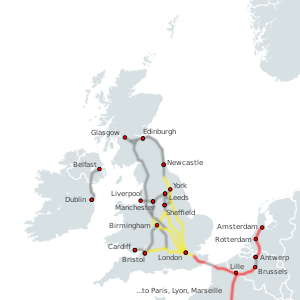
Back High-speed rail in the United Kingdom SIMPLE Birleşik Krallık'ta yüksek hızlı demiryolu Turkish

High-speed rail in the United Kingdom is provided on five upgraded railway lines running at top speeds of 125 mph (200 km/h) and one purpose-built high-speed line reaching 186 mph (300 km/h).
Trains currently travel at 125 mph (200 km/h) on the East Coast Main Line, Great Western Main Line, Midland Main Line, parts of the Cross Country Route, and the West Coast Main Line. On the latter line, only tilting trains can reach this maximum speed due to the difficult track geometry.
The 67 miles (108 km) long High Speed 1 (HS1) line connects London to the Channel Tunnel, with international Eurostar services running from London St Pancras International to cities in France, Belgium, and the Netherlands at 186 mph (300 km/h).[1] That line is also used by high-speed commuter services from Kent to the capital, operating at top speeds of 140 mph (225 km/h).
Since 2019 construction was ongoing on a major new purpose-built high-speed rail line, High Speed 2 (HS2) which would link London with major cities in the North and the Midlands at 224 mph (360 km/h) and reduce journey times to Scotland.[2] Government-backed plans to provide east–west high-speed services between cities in the North of England are also in development, as part of the Northern Powerhouse Rail project.[3]
There has been no single national rail operator in the UK since British Rail was privatised in the 1990s. High-speed services are provided by Avanti West Coast, CrossCountry, East Midlands Railway, Eurostar, Grand Central, Great Western Railway, Hull Trains, London North Eastern Railway, Lumo, Southeastern and TransPennine Express.
- ^ "About Us – High Speed 1". Archived from the original on 11 June 2017. Retrieved 8 April 2019.
- ^ "All stations to regeneration? Work on HS2 begins in earnest". TheGuardian.com. 19 January 2019. Archived from the original on 8 April 2019. Retrieved 8 April 2019.
- ^ "Northern Powerhouse Rail". Archived from the original on 4 April 2019. Retrieved 8 April 2019.
© MMXXIII Rich X Search. We shall prevail. All rights reserved. Rich X Search